13 Best Google Photos Alternatives
Updated: December 17, 2025 Author: Irina Nikolaeva
Is 15 GB of Google Photos storage no longer enough for you? Or are you concerned about privacy issues that Google might pose? Then this article is for you. We’ll discuss the best Google Photos alternatives for different user categories, covering options from mobile-only apps to ready-to-use NAS systems.
Google Photos has long been a preferable option for many users due to its free storage and ease of use. Today however, the demand for cloud storage continues to rise and, unfortunately, Google's policy ended unlimited free storage in 2021. This has provoked many loyal Google users to look for other solutions with similar or advanced features to store their media files.
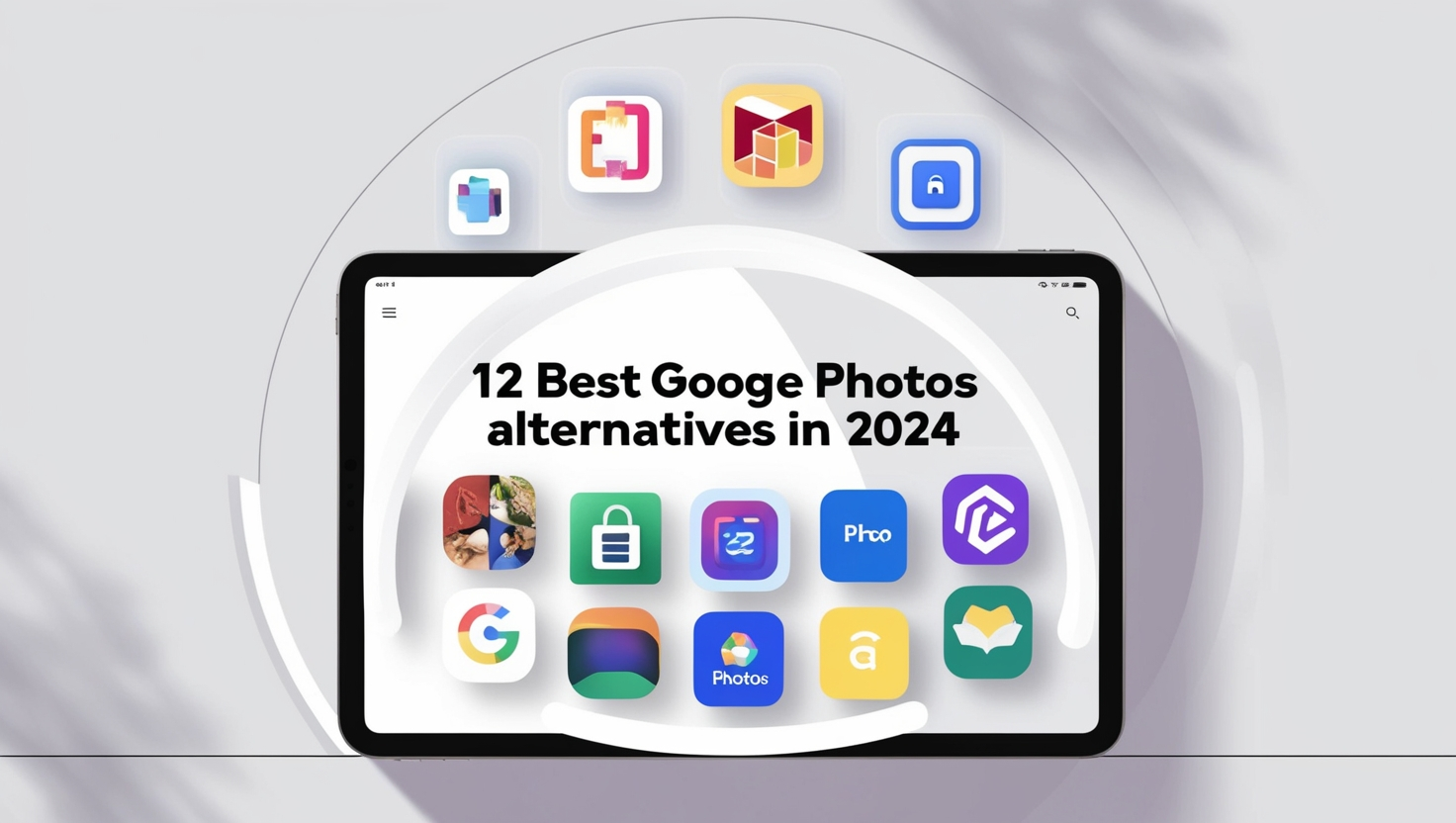
In this article, we’re going to explore the best Google Photos alternatives in various categories: from desktop applications to ready-to-use NAS solutions. We’ll discuss their features, available platforms and pricing plans. But first, for the sake of comparison, let’s take a look at the main features, advantages, and drawbacks of Google Photos.
Google Photos Overview

Google Photos mobile app offers an automatic backup feature, so your photos and videos are instantaneously stored in the cloud. AI can help you organize photos by recognizing faces, objects and locations, so that it’s easier to search for specific pictures. In addition to that, you can conveniently find images by using the app’s search tool and simply typing in such keywords as “vacation” or “summer.” Google Photos is accessible through any web browser and available as an app on iOS and Android.
The tool also provides very basic editing tools like cropping and filters as well as adjustments for brightness, contrast, and saturation. Another great advantage is that the service can automatically create albums, animations and collages from your media files to help you relive those beautiful moments in your life. Sharing your photos and albums is easy via links or directly to social media platforms.
Google Photos offers 15GB of free storage shared across all Google services. If you need more, there are paid plans: $1.99 per month for 100GB and $9.99 per month for 2TB.
Pros
- Seamless integration with Android devices
- Simple and intuitive, user-friendly interface
- AI-powered search capabilities make finding photos easy and efficient
Cons
- The end of unlimited free storage means users must manage their storage more carefully or pay for additional space
- Google Photos also lacks tools for managing storage, such as deduplication which would be very helpful for those with a free version
- Some users find face recognition to be poor quality
- As with any cloud service, there are concerns about data privacy and security
- Requires an internet connection to access and back up photos
- Editing is very limited and basic
With that understanding of Google Photos, let’s explore alternative solutions to see which ones might better suit your needs.
Google Photos Alternatives
Best for Organizing Large Photo Collections on a Desktop
The following desktop applications are designed specifically for managing and cataloging extensive photo libraries. Unlike Google Photos, which focuses on cloud storage, these tools prioritize efficient organization and searching of local photo collections, with storage management being a separate consideration.
Tonfotos
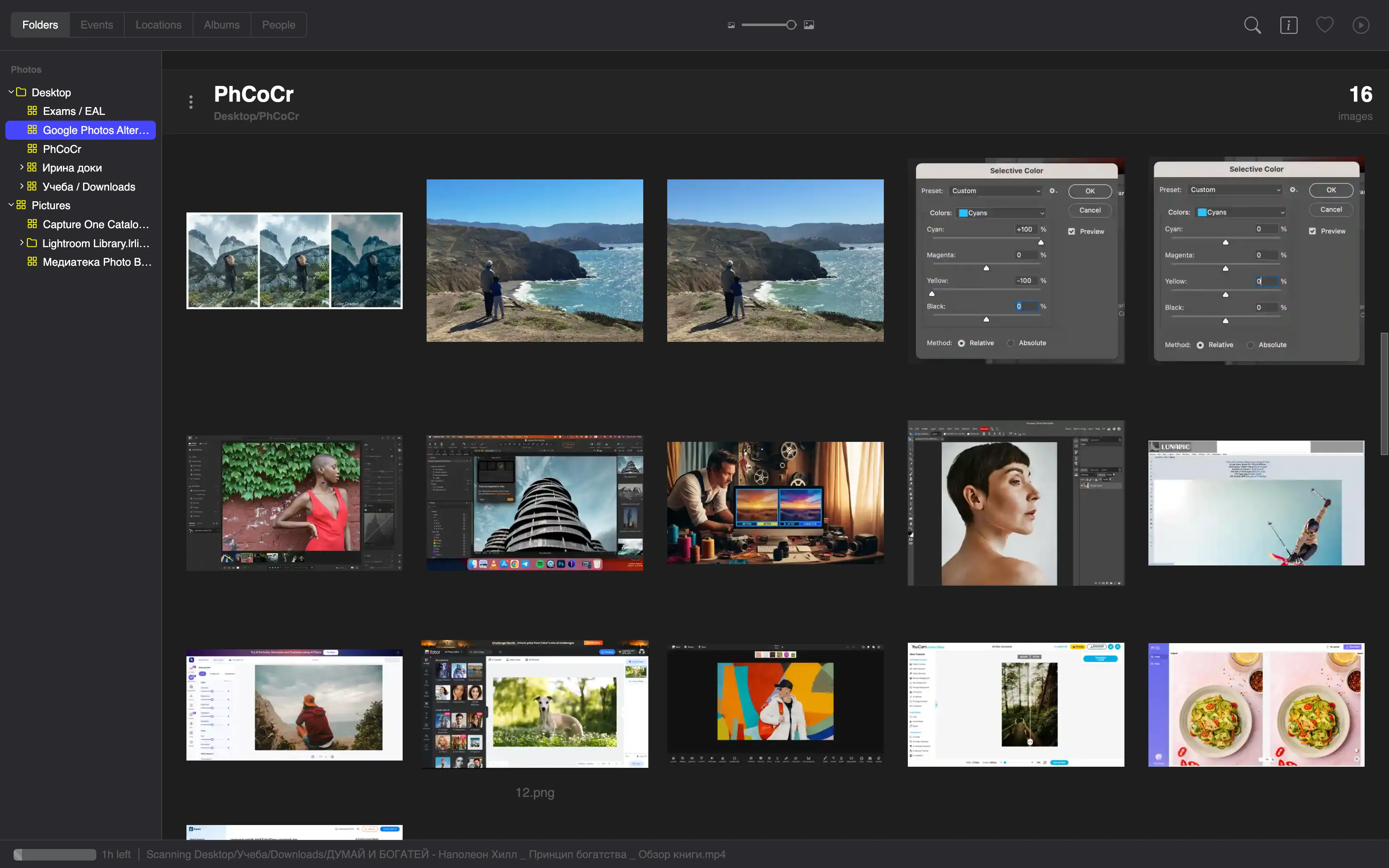
Tonfotos is a desktop application that can help you organize photo collections by automatically grouping pictures based on events, dates, people and locations. Regardless of where they’re stored — whether on your computer, external drives, NAS or even cloud — the tool makes it easy to find the exact photo you’re looking for.
Its advanced face recognition technology uses modern neural networks to identify faces in photos, learning from already tagged images and making the process of organizing your photos by people remarkably efficient. Tonfotos provides features like animated slideshows, geo-tagging, and handling of various photo formats.
This software allows you to store your photos wherever you prefer — whether in the cloud of your choice, on your computer, or external drives — without vendor lock-in or monthly fees. This gives you complete control over your photo storage. Moreover, Tonfotos supports a range of functionalities such as duplicate detection, detailed genealogical data storage, and automatic imports from smartphones.
Pros
- Advanced AI face recognition. Many users report that Tonfotos offers some of the most effective face recognition technology, allowing for detailed and accurate tagging of faces compared to other solutions.
- Intuitive, user-friendly interface
- No cloud service lock-in or monthly fees
- Supports a variety of image and video formats, such as RAW images from professional cameras
- Automatically organizes photos by events, dates, and locations
- Compatible with macOS, Windows, Linux
- Offers automatic import feature: effortlessly download pictures from your smartphone to your PC or laptop
- Easily finds and removes duplicate photos
- Enables offline mode for easy access
- Regular updates and improvements driven by a dedicated community
Cons
- No backups functionality
- The number of recognized persons is limited in the free version
Pricing: Free with limited features; lifetime license: from $59
Platforms: Windows, macOS, Linux
Website: Tonfotos
Digikam
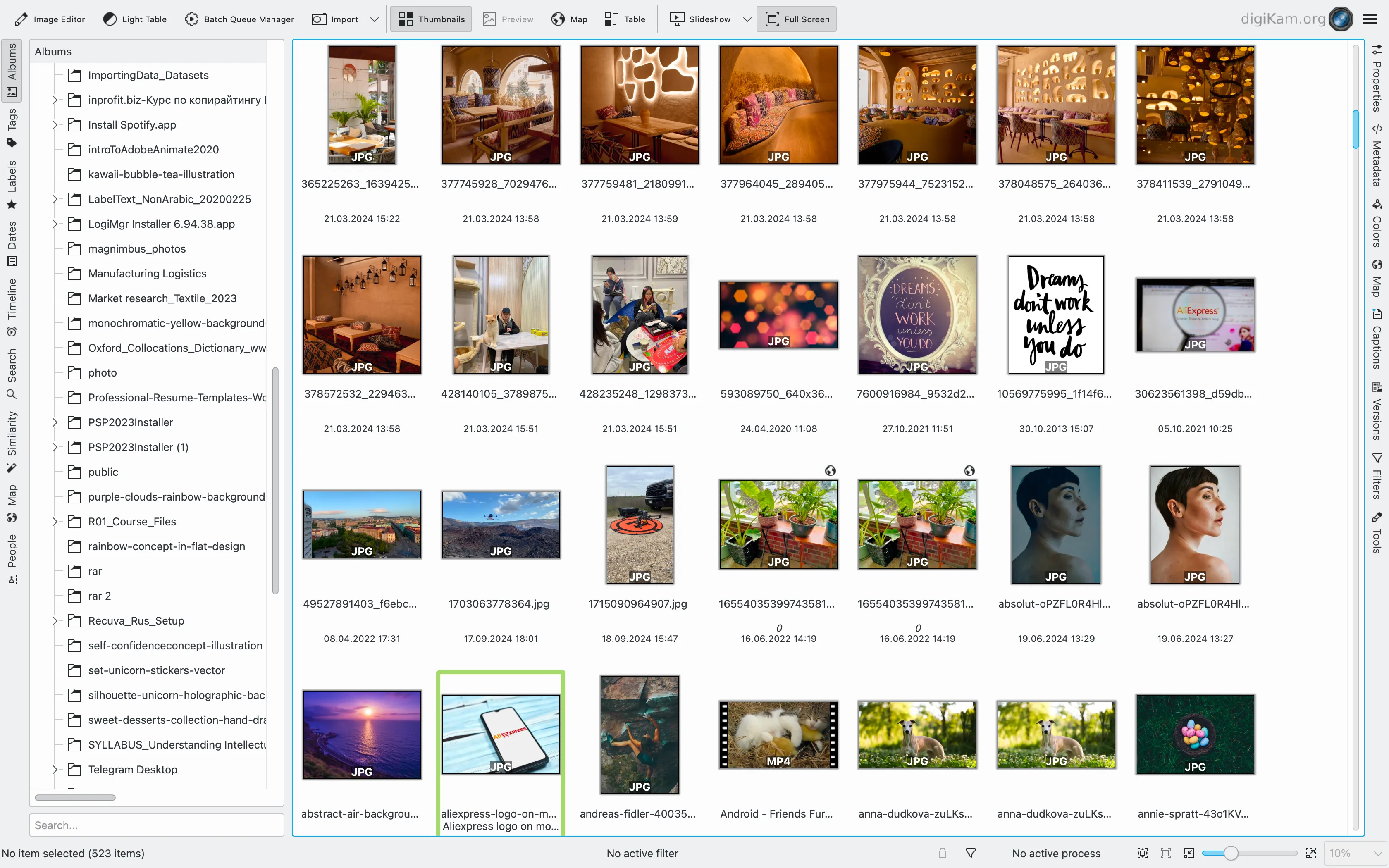
Being an open-source solution, this desktop Google Photos alternative helps users handle extensive photo collections by sorting images into albums that are organized chronologically, by folder layout, or custom collections. The software also includes metadata management, allowing users to view and edit metadata such as EXIF, IPTC and XMP.
In addition, you can use a set of editing tools in DigiKam, such as red-eye correction, color adjustments, and noise reduction. DigiKam also provides a feature called “Light Table” — a tool that can help you to compare and analyze multiple photos side by side and pick the one you like most, as well as Batch Queue Manager for processing multiple images simultaneously with pre-configured workflows.
Pros
- Offers a wider than Google Photos range of editing options suitable for both amateur and advanced users
- As an open-source application, DigiKam is free to use, with regular updates and improvements driven by a dedicated community
Cons
- The extensive features and options can be overwhelming for beginners
- Albums are created by copying files into new folders, which can result in duplicates and clutter in your archive.
- The interface may seem complex and non-intuitive for new users
- No direct import feature from your smartphone to your PC or laptop
- Face recognition feature is limited, with basic functionality for finding faces but poor accuracy in identifying similar faces, requiring mostly manual tagging.
Pricing: Free
Platforms: Windows, macOS, Linux
Website: DigiKam
Adobe Lightroom Classic
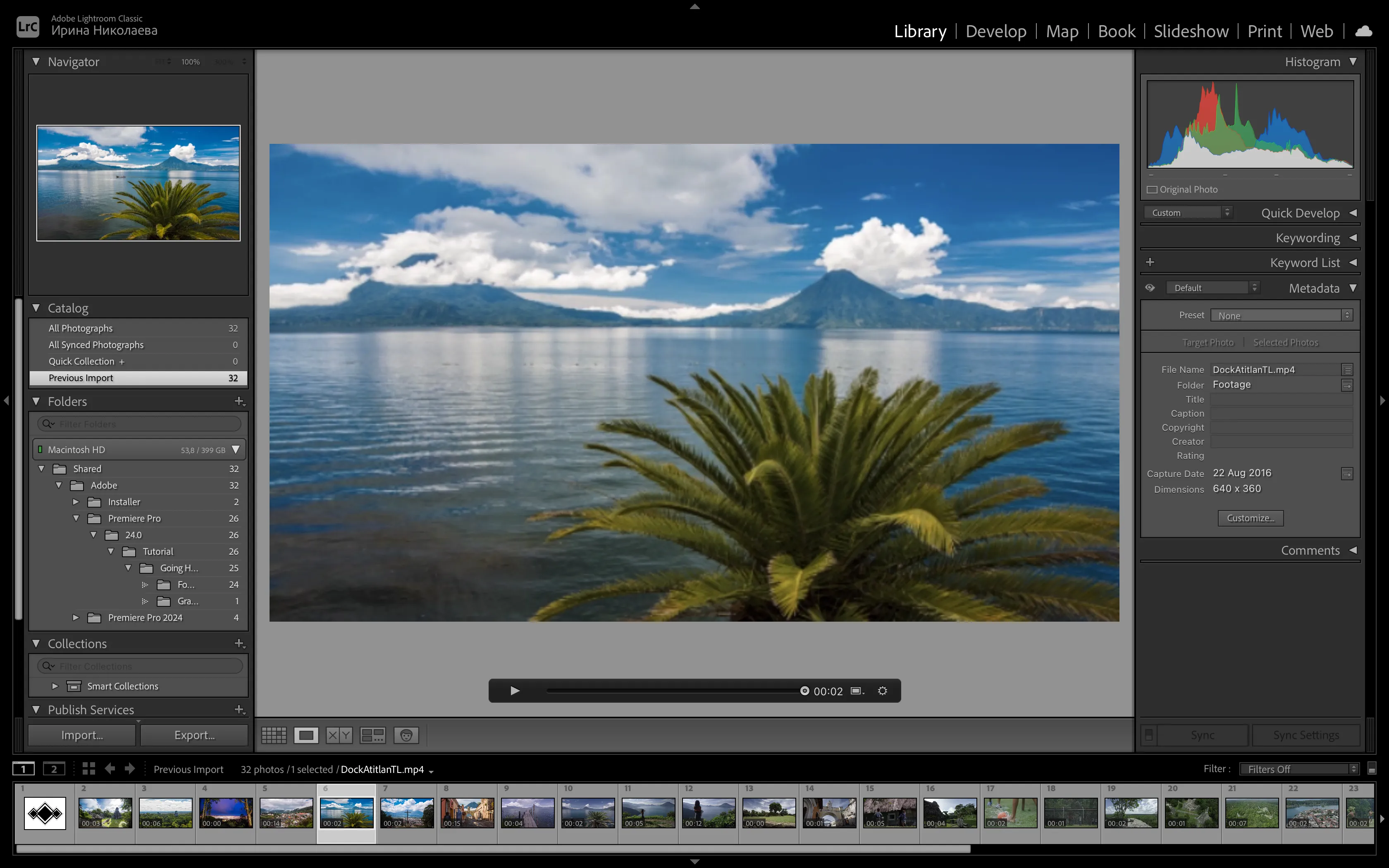
Lightroom Classic might be a good choice for professional photographers in need of a photo organization tool with advanced editing tools. This alternative to Google Photos excels thanks to its cataloging system, metadata tagging and collection organization. Users can organize large libraries by creating detailed catalogs and applying keywords. Lightroom allows you to find and organize photos by people's faces. You can choose whether you want the program to search for certain people's faces or by some specific criteria, for example, name, gender, age.
Editing tools include color grading and local adjustments. Recent updates introduced AI-based features called Generative Remove, which allows seamless object removal, and AI Lens Blur, which adds an aesthetic blur effect to any part of your photo. Finally, Lightroom Classic supports HDR editing, which allows users to produce pictures with greater depth and more vivid colors.
Lightroom Classic is part of the Adobe Creative Cloud Photography Plan, which includes Photoshop and 20 GB of cloud storage.
Pros
- Advanced organization features like cataloging and keywords
- A comprehensive suite of editing tools, including AI-powered enhancements
- Allows for editing and exporting in High Dynamic Range
- It’s possible to download all your desktop photos to your phone
Cons
- Extensive features can be overwhelming for non-professional photographers
- Requires an Adobe Creative Cloud subscription, which can be costly
- Some users might experience slow performance with large catalogs
- The design of the Classic version seems to be a bit outdated and not quite intuitive, unlike other Adobe programs
Pricing: Plans starting at $9.99 per month. Other plans with additional storage and features are available.
Platforms: Windows, macOS
Website: Adobe Lightroom Classic
Best Mobile-Only Google Photos Alternatives
This category provides a selection of tools designed specifically for managing your photo library on the go. These apps offer various features to help you organize, sort, and share your images directly from your smartphone. Whether you need enhanced privacy, organizational tools, or seamless transfer capabilities, these mobile-only options provide valuable alternatives.
Piktures
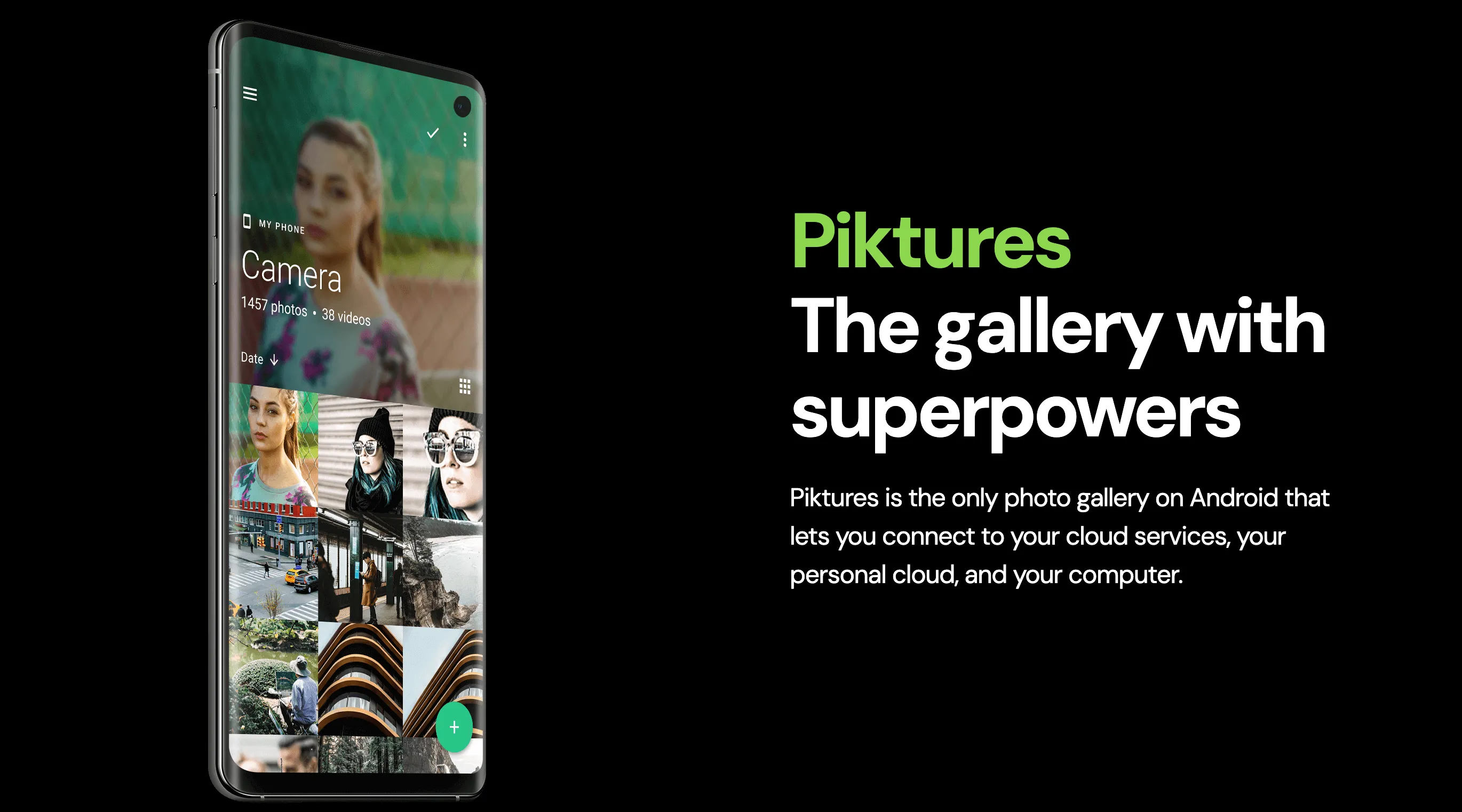
Piktures is a mobile-only photo gallery app available for Android users. The app has a user-friendly interface for managing photos. This Google Photos alternative supports various media formats, like images, videos, GIFs and so on. It’s great in terms of proving privacy: you can secure your photos with a PIN code or store them in an encrypted vault.
Piktures integrates with cloud storage services like Google Drive, Dropbox, and OneDrive, allowing users to manage their cloud-stored photos directly within the app. By leveraging Google Drive, which was often more cost-effective than Google Photos, users could benefit from lower storage costs while using Piktures for efficient photo organization. The app offers useful tools for viewing photos by date, location, and even color, making it easier to catalog and access your images without breaking the bank.
Pros
- Intuitive and user-friendly interface
- Provides a secure, encrypted vault for private photos
- Supports multiple cloud services, allowing users to manage their cloud-stored photos within the app
- Offers various ways to organize and view photos, such as by date, location, and color
Cons
- Unlike Google Photos, Piktures does not offer its own cloud storage, requiring users to rely on third-party services
- Some users have reported occasional slow performance
- The app includes advertisements, which can be intrusive
- No features to identify and remove duplicate photos
- Does not offer search capabilities beyond basic tags and metadata
- No face recognition features
Pricing: Free version with in-app ads and only one storage choice Paid options start from $2.53 with ads removed and advanced features
Platforms: Android
Website: Piktures
Slidebox
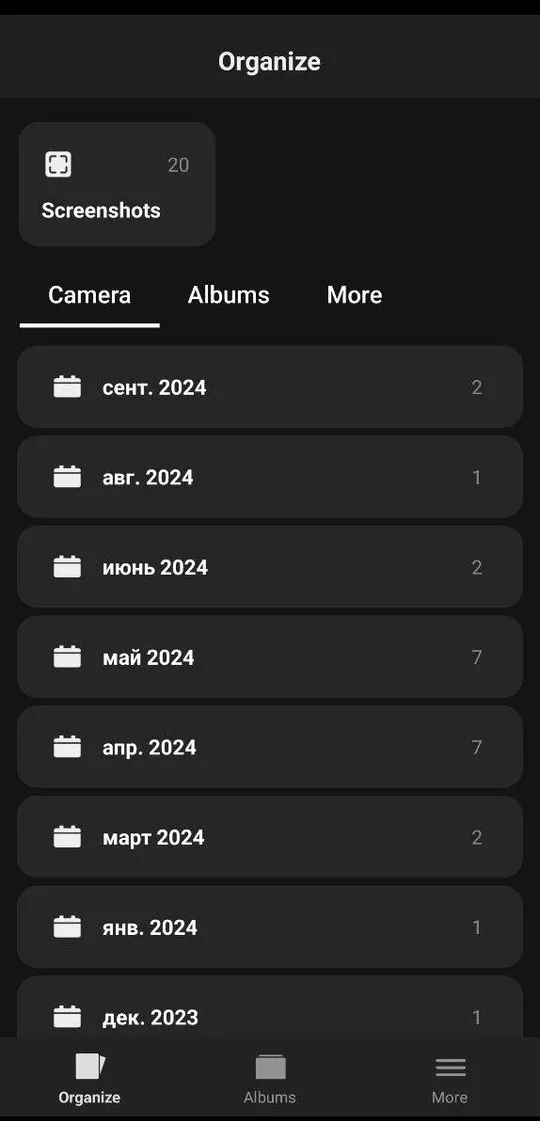
Slidebox’s unique gesture-based interface and syncing in real-time makes it a convenient choice for Android and iOS users for managing large photo collections. For instance, you can swipe up to delete, swipe left to skip and swipe down to add photos to albums.
What might attract users is the ability to create and organize photos into albums within the app, which will also be created in the device’s native photo gallery. Additional features include the ability to undo any changes, SD card support and video organization support.
Pros
- The app’s intuitive swipe gestures interface make the process easy and interactive
- Albums created in Slidebox are mirrored in the device's native photo gallery
- Includes features like comparing similar photos to help with decluttering
- The app prioritizes user privacy
Cons
- Some users find the feature set limited compared to other photo management apps
- Occasional bugs and performance issues have been reported
- Slidebox is focused on photo organization and does not offer its own photo storage feature
Pricing: Free version. Slidebox Premium price varies by country and comes with all features and no ads.
Platforms: Android, iOS
Website: Slidebox
PhotoSync

PhotoSync focuses solely on transferring photos and videos and does not offer photo organization or cataloging features. For a more comprehensive solution, it can be used in conjunction with photo management apps like Tonfotos or DigiKam.
PhotoSync supports several useful scenarios. For example, you can automatically transfer all new photos to your computer or NAS over Wi-Fi with just one tap. Whether you're looking to back up your media or sync it across devices, PhotoSync simplifies the process without needing to dive into technical details.
Pros
- Full user control over transfer settings and targets
- Supports various devices and platforms, including NAS and multiple cloud services
- Trusted by thousands of users with over 10 years in the market
Cons
- Some advanced features, such as automatic backups and family sharing, are only available in the Premium version
- Does not offer photo organization or cataloging features
Pricing: PhotoSync is free to download and use on Android and iOS. Premium features are available for iOS users for $0.99/month or $6.49/year. Android users can upgrade the app depending on their needs — there are various add-ons.
Platforms: Android, iOS
Website: PhotoSync
Best for Self-Hosting and Advanced Features
The tools in this category are ideal for users who want advanced functionalities like detailed organization, customization, and enhanced privacy without relying on third-party cloud services. They are well-suited for tech-savvy users who prefer to maintain full control over their data and storage solutions. Using any of those solutions requires owning your dedicated server connected to the Internet and having enough storage for your photo archive. Typically this is a NAS in your home, but it can also be set up on a rented virtual server from a hosting provider. To be able to run your self-hosted photo cloud, being proficient in server administration is a must, Docker knowledge is preferable.
Immich
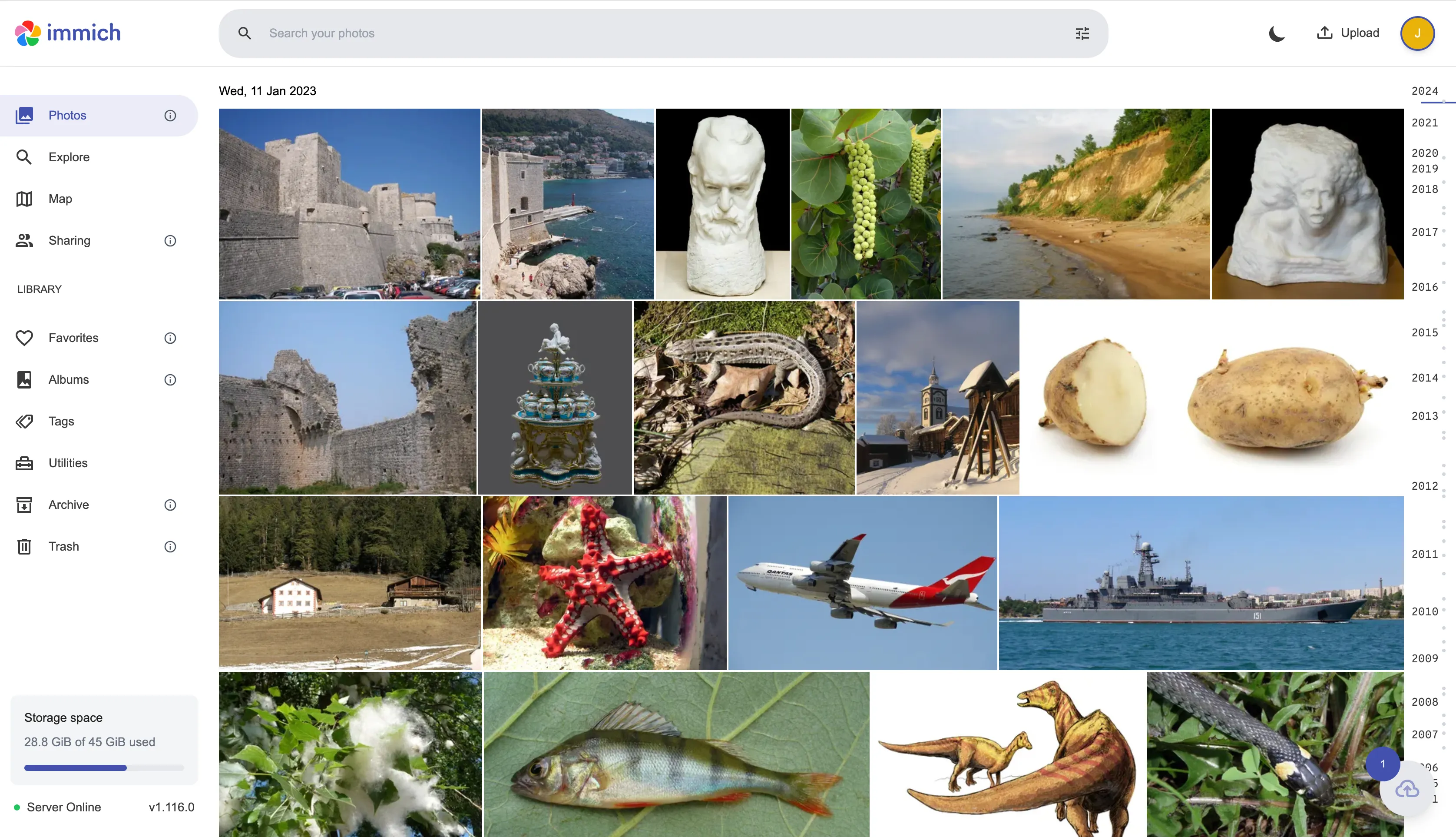
Immich is a free self-hosted photo and video management solution that provides users with complete control over their data. The features are similar to those of Google Photos: automatic backups, advanced organization, machine learning capabilities, and others. The platform supports offline access so that you can view and manage your photo library without an internet connection. As for organization features, Immich offers views based on timeline and location. ML algorithms help tag and categorize photos for a more efficient search. The AI-powered facial recognition feature identifies and groups individuals in photos, facilitating easy organization and retrieval.
Collaborative sharing is another key feature of this alternative to Google Photo. Users can share albums and individual photos with family and friends while maintaining control over privacy settings.
Pros
- Complete data control with self-hosting, eliminating reliance on third-party cloud services
- Dedicated apps for iOS and Android with offline access and automatic backups
- Machine learning-based tagging, AI facial recognition, and geotagging for efficient organization and search
- Easy and secure sharing with privacy controls
- Detects duplicate images
Cons
- Immich is under active development, meaning users may encounter bugs and changes
- Requires technical knowledge to set up and manage the server
Pricing: Immich is free to use. However, users need to provide their own server infrastructure, which may involve additional costs for hosting and maintenance.
Platforms: Android, iOS, Windows, macOS
Website: Immich
NextCloud
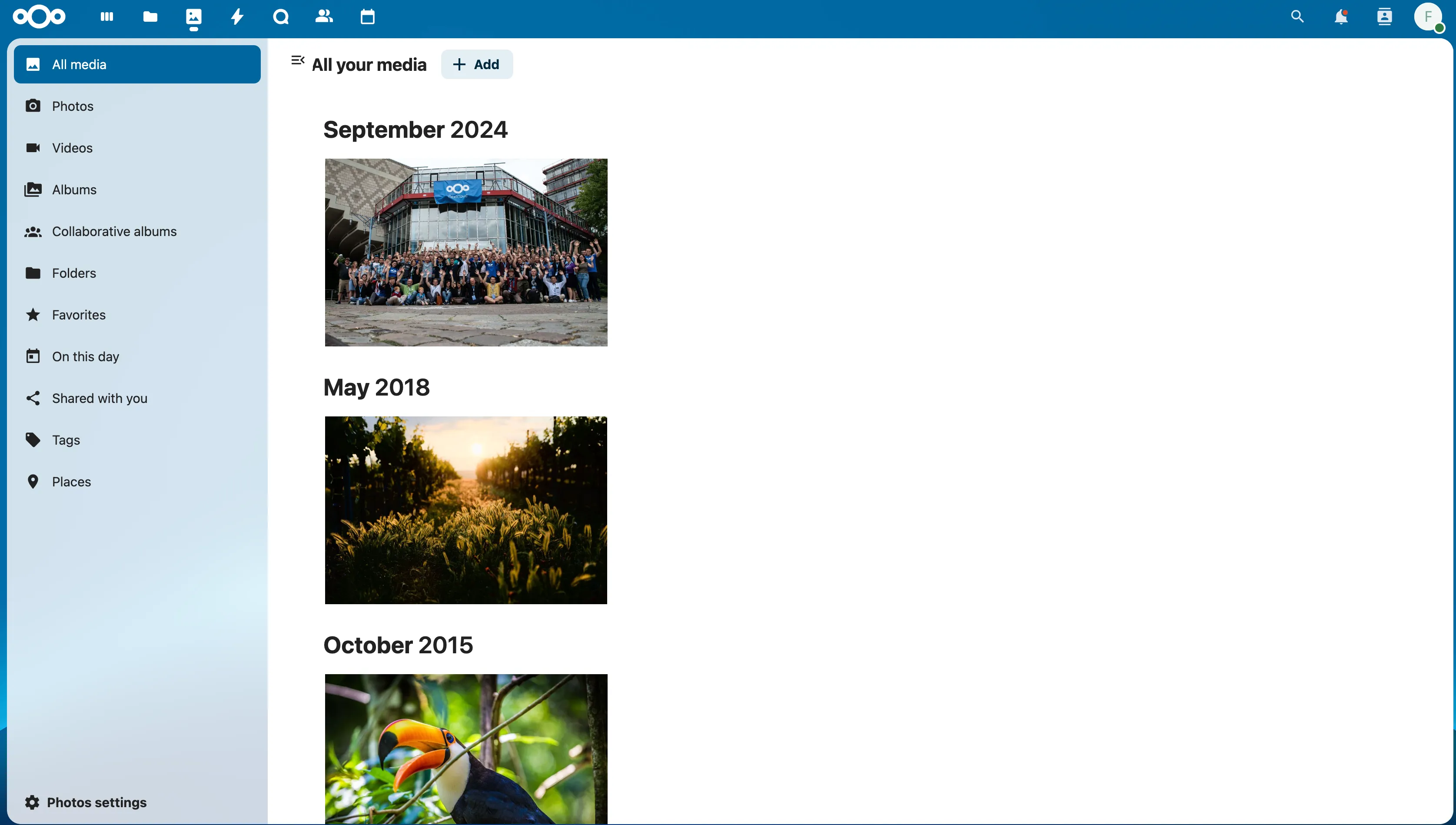
Nextcloud is another self-hosted cloud platform that offers a powerful alternative to Google Photos for users who prioritize data privacy and control. Nextcloud is highly customizable, making it suitable for both individuals and organizations looking for a comprehensive solution to manage files, photos, and collaborative projects.
The platform supports automatic photo backups from mobile devices. It features AI-powered object and face recognition, allowing users to categorize and search their photo libraries efficiently without sending data to third-party services. The Photos 2.0 app within Nextcloud also offers integrated photo editing tools, enabling users to manage and enhance their images directly within the platform. In addition to photo management, this Google Photos alternative includes robust collaboration tools. It integrates with popular services like Microsoft Office, Google Drive, and other cloud platforms, allowing seamless file sharing and editing.
Pros
- Free and open-source
- Self-hosted and third-party hosted data options
- No data is sent to third-party servers; all processes, including AI features, run locally
- Integrates with various services and provides secure communication options
- Supports a wide range of apps and integrations, making it adaptable to various needs
Cons
- Requires technical knowledge to set up and manage the server.
- Only manual tagging album creation
- Does not offer built-in duplicate detection and removal for photos
Pricing: Nextcloud is free for individuals. Enterprise versions with additional support and features are available, but pricing varies depending on the scale and requirements.
Platforms: Windows, macOS, Linux, iOS, Android
Website: NextCloud
Ente.io
Ente is a great Google Photos replacement for users concerned about photo privacy. It's an open-source cloud storage service with end-to-end encryption (E2EE). Unlike Google, which scans your photos to train its algorithms and serve ads, Ente uses a zero-knowledge architecture. This means only you have the keys to view your photos, and not even the service's developers can see the data.
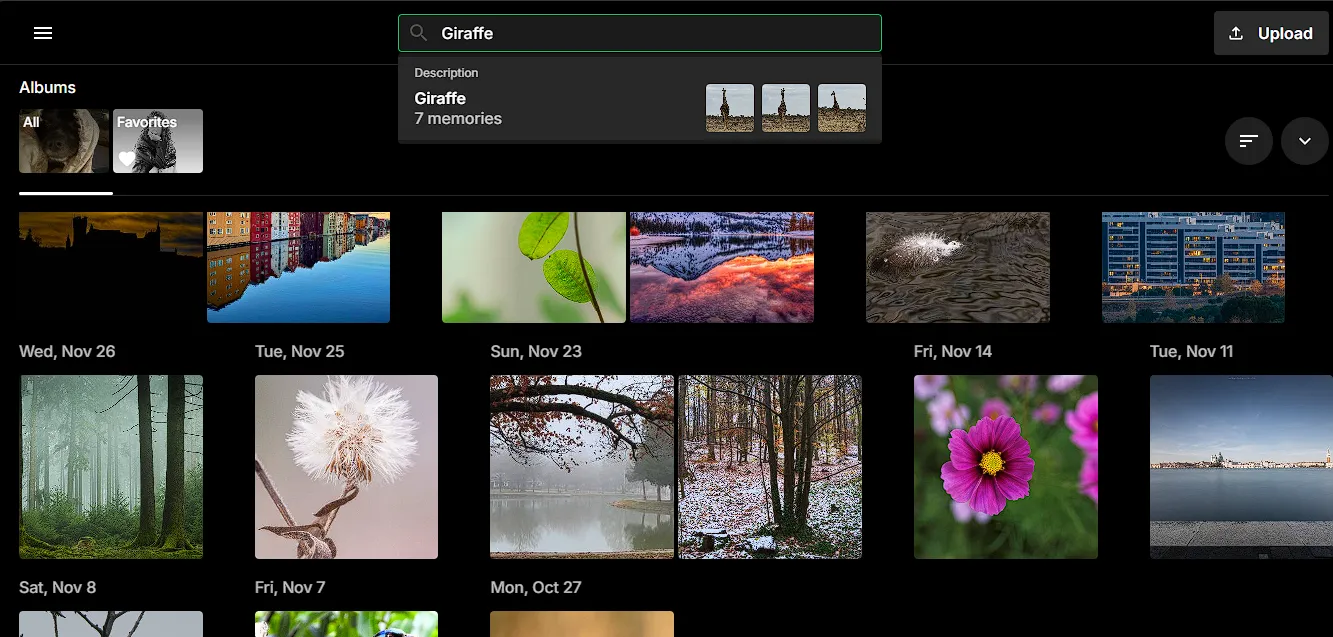
Despite its strict approach to security, Ente doesn't sacrifice convenience. It offers features familiar to Google users: automatic backups, album creation, memories, and the ability to share with family and friends.
Facial and object recognition occurs directly on your device (smartphone or computer), not in the cloud. This allows you to search for photos by keywords like "birthday," "cat," or people's names, all while maintaining your privacy.
The mobile apps have a modern design and allow you to easily import libraries from Google Photos, Apple Photos, and local drives, leaving the album structure intact.
Pros
- End-to-end encryption (E2EE) ensures complete confidentiality.
- Fully open source code, independently security audited.
- Local AI for facial and object recognition works quickly and does not transmit data to servers.
- Cross-platform: excellent mobile apps for iOS, Android, a web version, and a functional desktop app (Linux, macOS, Windows).
- Family Sharing lets you share storage space and albums at no extra cost.
- Support for Live Photos and high-quality video playback.
- A simple migration tool to migrate your entire library from Google.
Cons
- The cost is higher compared to unsecured cloud storage due to the greater load on the infrastructure for data encryption.
- If you lose your recovery key, you'll lose access to your photos forever. Support won't be able to help you reset your password.
- Initial indexing and encryption of a large library can take time and device resources.
Platforms: Open source and self-hosted
Website: Ente.io
Piwigo
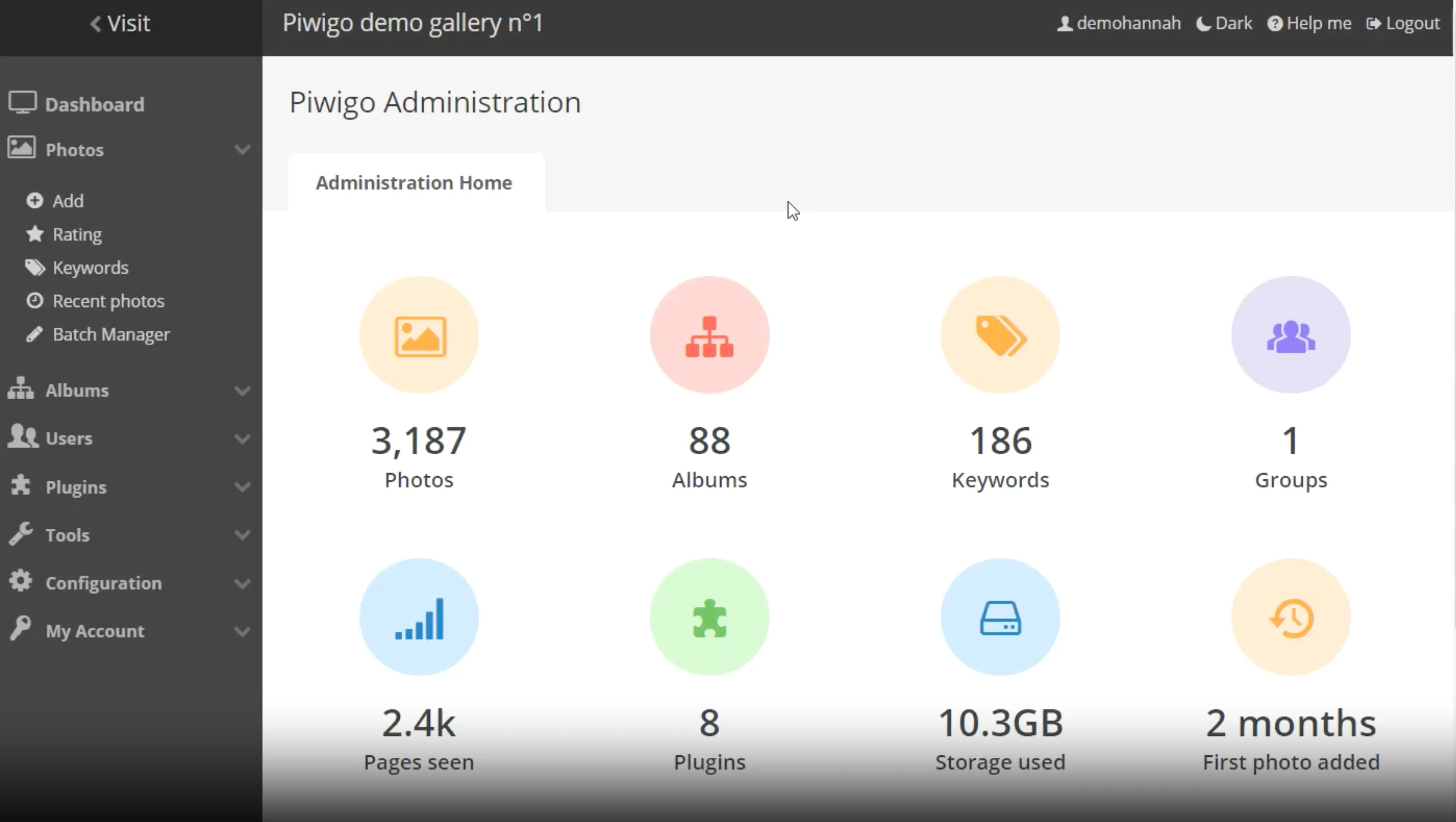
Piwigo allows users to host their photo galleries on their own servers, providing complete control over data and privacy. The platform supports a variety of ways to upload photos, including via the web, FTP, and desktop apps like Shotwell and Lightroom. Photos can be organized into albums, geotagged, and edited with metadata. Piwigo also offers batch management tools that make it easy to apply actions like tagging or altering author details across multiple photos simultaneously.
Customization is another strong point of Piwigo. Users can enhance the platform’s functionality with plugins and themes, allowing for a tailored experience that meets specific needs. Piwigo also includes built-in tools for user management, access control, and analytics, making it a powerful option for collaborative projects. The platform supports a wide range of file formats and provides unlimited storage when self-hosted.
Pros
- Self-hosting allows for full ownership and control over your data, with no reliance on third-party services
- Extensive plugin and theme support enable users to customize their experience
- Capable of handling large photo libraries, making it suitable for both personal and professional use
- Supports multiple upload methods and integrates with popular photo management tools
- The Smart Albums plugin lets you create albums that are automatically populated according to predefined rules.
Cons
- Requires technical knowledge to set up and maintain the server, including managing updates and backups
- Doesn’t offer built-in face recognition feature
- Auto-tagging is available only through additional plugin
Pricing: Piwigo is free to use when self-hosted. However, users must provide their own server infrastructure. For those who prefer not to manage their own hosting, Piwigo offers a cloud-hosted service starting at €39 per year with 10GB storage.
Platforms: Self-hosted on any server. Mobile support on Android and iOS
Website: Piwigo
Ready-to-Use NAS Solutions
Ready-to-use NAS solutions provide the convenience of self-hosted storage without the complexity of open-source setups. While these solutions still require hardware (your own NAS device), they come from NAS vendors and are designed to be far more user-friendly. The biggest advantage is that they require much less technical skill to set up and manage. You don’t need to be an advanced admin or have knowledge of Docker. Instead, even a regular user can get a centralized, reliable solution for organizing, accessing, and sharing photos across their home or office network with minimal configuration.
Synology Photos
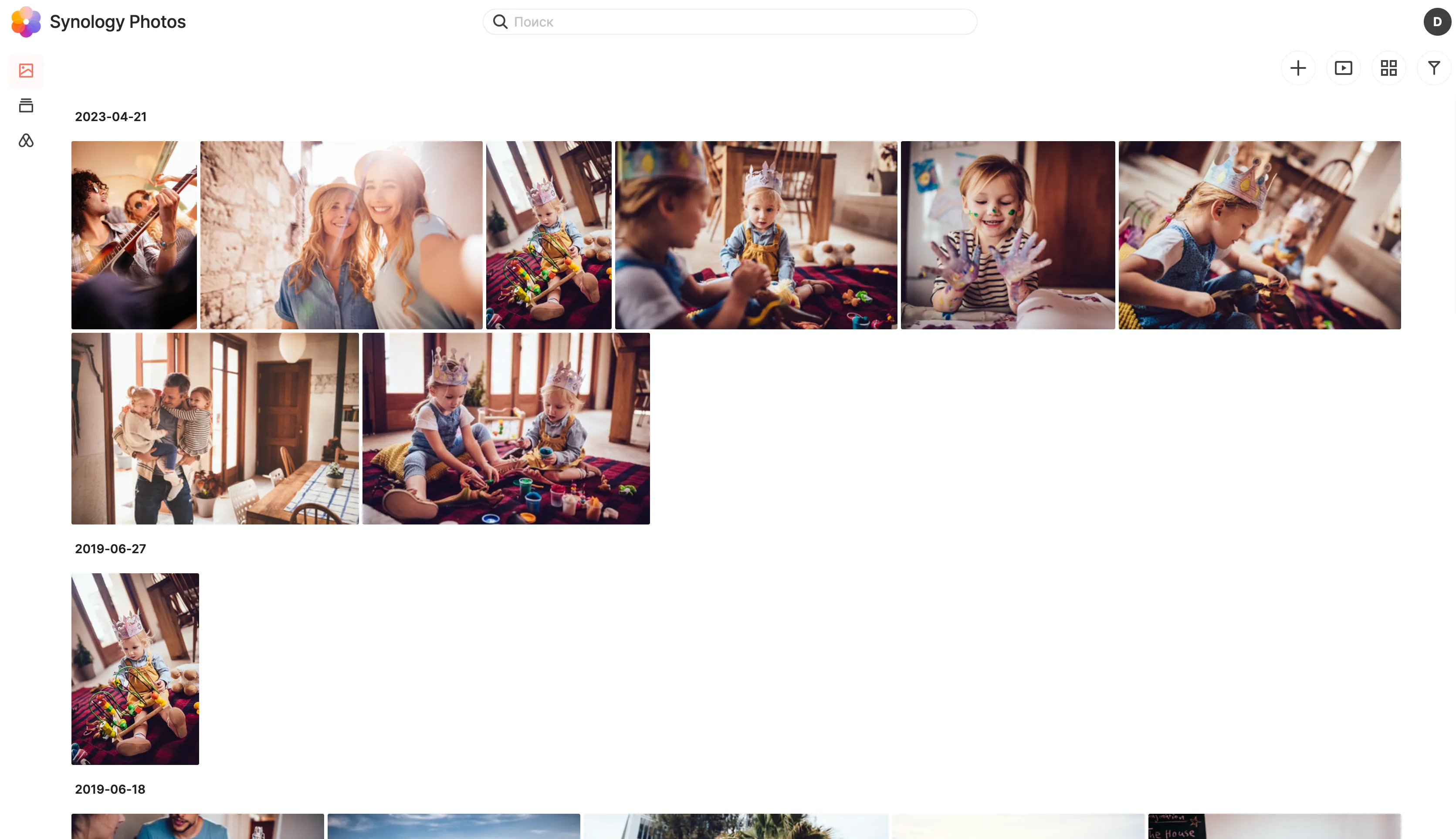
Synology Photos supports automatic photo backup from mobile devices, ensuring that all your media is securely stored on your NAS. The platform offers comprehensive organization tools, including timeline and folder-based views, which allow users to easily navigate their photo library.
The user interface is designed to be intuitive, making it easy for users to upload, organize, and share photos. Sharing features are robust, with options to create shared albums or use shared spaces for collaborative photo management. The mobile apps for iOS and Android further enhance the user experience by allowing users to manage their photos on the go, with features like automatic backup and the ability to free up local storage by offloading photos to the NAS.
Pros
- All data is stored on your NAS, minimizing reliance on external cloud services
- Automatic photo backup from mobile devices with support for detailed organization
- Seamless integration with other Synology products and services
- Designed to be accessible and easy to navigate, even for non-technical users
- Allows for automatic album creation (like People, Places, etc.)
Cons
- Less accurate facial recognition features, requiring manual intervention to organize faces correctly
- Lacks more advanced AI-powered search and categorization features found in other platforms like Google Photos.
- Offers only manual tagging
- No buil-in duplicate detection feature
- Setting up a NAS and configuring Synology Photos requires some technical knowledge
Pricing: Synology Photos is included with Synology NAS devices, meaning there is no additional cost beyond the purchase of the hardware. However, users need to factor in the cost of the NAS and the drives needed to store their data.
Platforms: Self-hosted on Synology NAS. Mobile support on Android and iOS
Website: Synology Photos
QNAP QuMagie
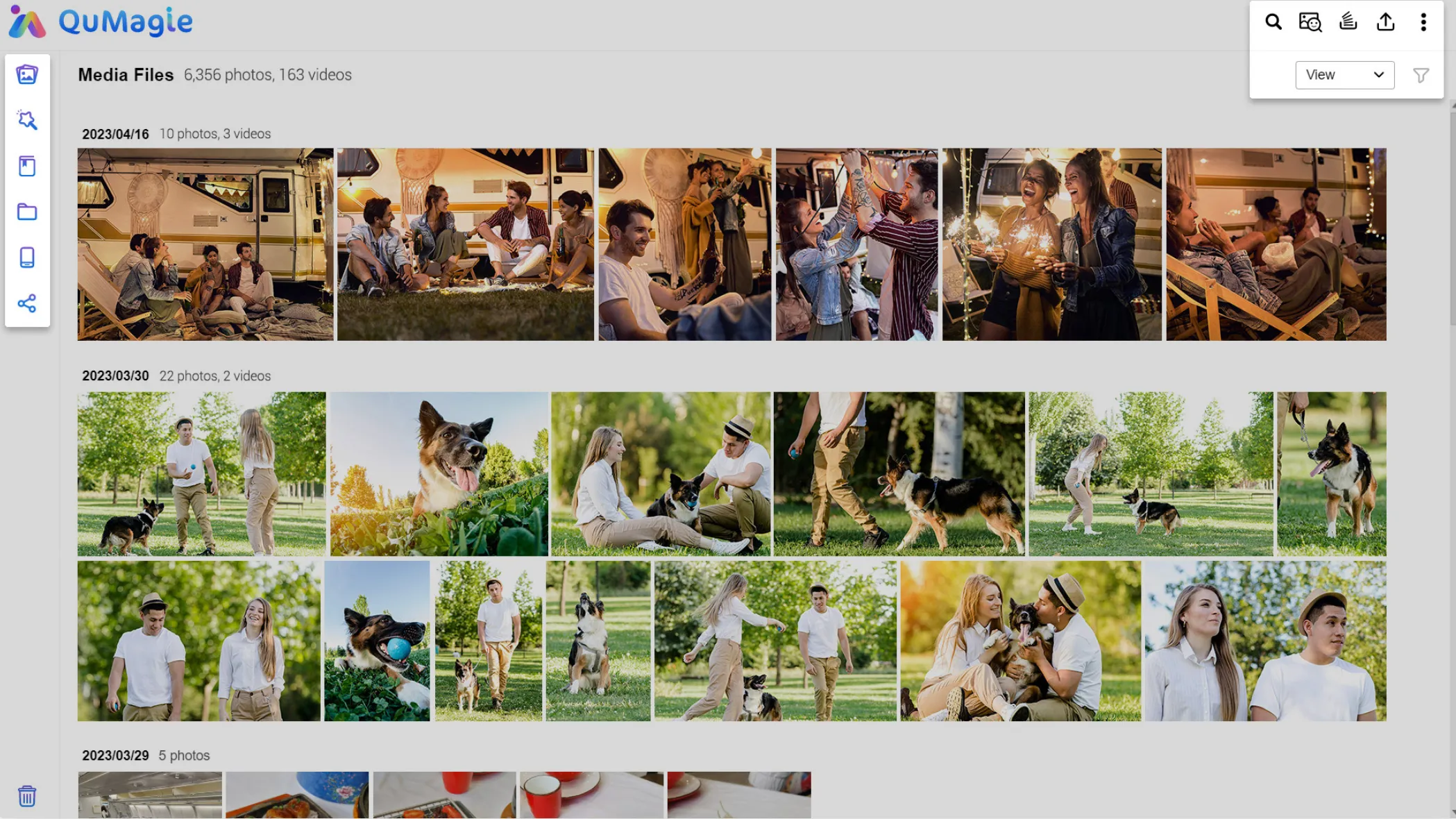
QuMagie’s AI capabilities extend beyond simple organization, allowing for automatic tagging and categorization of photos. The platform’s AI can recognize and sort images by faces, objects, and locations, which is especially useful for users with large photo collections. Additionally, QuMagie includes a timeline scroll feature, which lets users view their photos chronologically, and customizable folder covers to personalize their photo library.
QuMagie also offers robust mobile support through the QuMagie mobile app, available for both iOS and Android. This app allows users to view and manage their photos stored on the NAS remotely, ensuring that their media is accessible anytime and anywhere. The app also supports offline viewing, so users can download and view photos without an internet connection.
Pros
- Advanced AI features for facial recognition, object identification, and geotagging
- Streamlined interface with timeline views and customizable folder covers for easy navigation
- Automatic tagging and categorization of photos
- Full-featured mobile app for remote access and offline viewing of photos
- All data is stored on the user’s NAS, ensuring complete control and privacy
- The Smart Album feature automatically add photos and videos that match a specified criteria
Cons
- Setting up and configuring a QNAP NAS with QuMagie may require some technical knowledge
- Requires a QNAP NAS, which involves an additional hardware investment
- No built-in duplicate detection and removal tool
Pricing: QuMagie is included with QNAP NAS devices, so there are no additional software costs. However, users must purchase a QNAP NAS and the drives to use the service.
Platforms: Self-hosted on QNAP NAS. Mobile support on Android and iOS.
Website: QuMagie
WD My Cloud Home
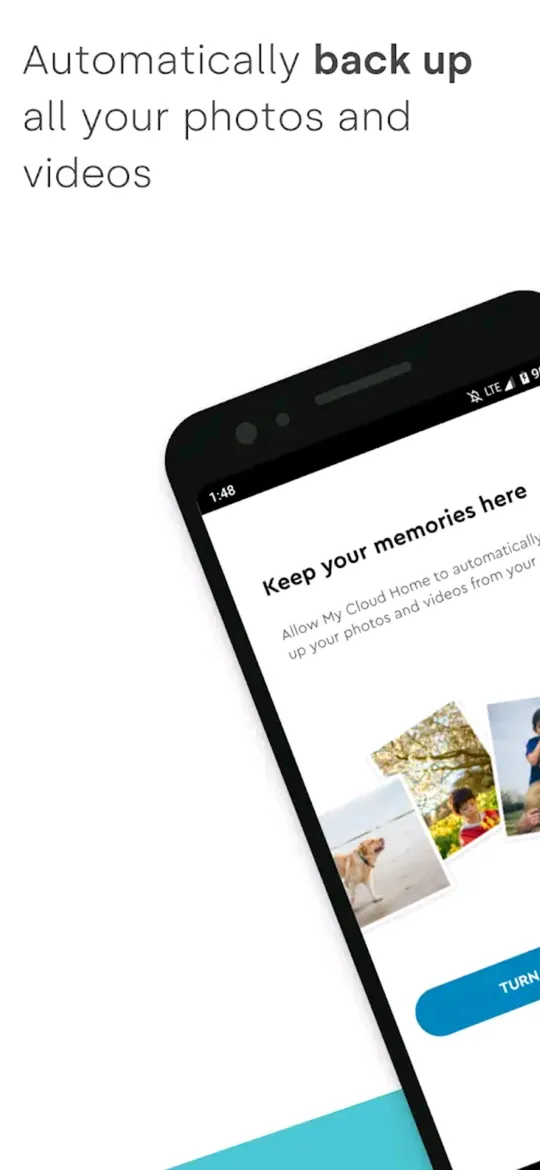
WD My Cloud Home provides a centralized location for all your media files and offers seamless integration with various devices, making it a popular choice for personal use. It simplifies photo management with automatic backup capabilities, offers a straightforward setup process and provides users with a dedicated My Cloud Home mobile app for iOS and Android.
The device supports automatic photo uploads from mobile devices, ensuring that all your memories are backed up without manual intervention. It also includes a simple web interface for managing and organizing photos, making it easy to sort and view your media collection.
Pros
- Simple setup and intuitive interface make it accessible for users of all skill levels
- The mobile app provides easy access to photos from anywhere, with offline viewing capabilities
- Automatic photo and video uploads from mobile devices ensure that your media is securely backed up
- Offers duplicate detection and removal feature
Cons
- Lacks advanced photo management features found in more complex NAS solutions
- Does not offer sophisticated AI-powered organization or facial recognition
- Requires purchasing WD My Cloud Home hardware, which involves an additional investment
- No face recognition feature
- No automatic tagging and album creation
Pricing: WD My Cloud Home is available in various storage capacities, with pricing depending on the chosen model. Prices start from $169.99 for the 4TB model, with higher capacities costing more.
Platforms: Self-hosted on WD My Cloud Home NAS. Mobile support on Android and iOS.
Website: My Cloud Home
Bottom Line
Whether you're looking for robust desktop Google Photos alternatives like Tonfotos and Lightroom Classic, mobile-only apps such as Piktures and Slidebox there is a solution to fit every requirement. Self-hosting enthusiasts can benefit from platforms like Immich and NextCloud. Finally, ready-to-use NAS solutions such as Synology Photos, QNAP QuMagie, and WD My Cloud Home provide comprehensive storage and management options with easy setup.
Each alternative presents unique features and advantages tailored to different use cases, from advanced photo organization and management to enhanced privacy and cloud integration. When selecting the right tool, consider your specific needs—whether it's mobile access, desktop capabilities, or self-hosted solutions—to find the best fit for your photo management and storage needs.